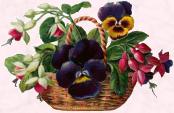
Friday, April 22, 2011
Wednesday, April 13, 2011
What is Perfume Made From?
Perfume is made from about 78% to 95% of specially denatured ethyl alcohol and a remainder of essential oils.
Perfume is the costliest form of fragrance with 22% of essential oils.
Eau de Parfum (EDP), comes next with between 15 and 22% essential oils.
That's followed by Eau de Toilette (EDT) with 8 to 15% oils.
The weaker Eau de Cologne has just 4% essential oils.
For those who crave super subtlety Eau Fraiche with 1 to 3% essential oils, is the lightest dilution of fragrance.
Many new perfumes are promoted as EDPs and an EDT is not always produced as there has been a vogue for Eau de Parfum as individuals want a more lasting signature. http://www.fashion-era.com/perfume_history.htm
Perfume is the costliest form of fragrance with 22% of essential oils.
Eau de Parfum (EDP), comes next with between 15 and 22% essential oils.
That's followed by Eau de Toilette (EDT) with 8 to 15% oils.
The weaker Eau de Cologne has just 4% essential oils.
For those who crave super subtlety Eau Fraiche with 1 to 3% essential oils, is the lightest dilution of fragrance.
Many new perfumes are promoted as EDPs and an EDT is not always produced as there has been a vogue for Eau de Parfum as individuals want a more lasting signature. http://www.fashion-era.com/perfume_history.htm
Tuesday, April 5, 2011
History of Perfume
Photo:
The Perfume Maker, by Rodolphe Ernst
Perfume is thousands of years old - the word "perfume" comes from the Latin per fume "through smoke". One of the oldest uses of perfumes comes form the burning of incense and aromatic herbs used in religious services, often the aromatic gums, frankincense and myrrh, gathered from trees. The Egyptians were the first to incorporate perfume into their culture followed by the ancient Chinese, Hindus, Israelites, Carthaginians, Arabs, Greeks, and Romans. The earliest use of perfume bottles is Egyptian and dates to around 1000 BC. The Egyptians invented glass and perfume bottles were one of the first common uses for glass. http://inventors.about.com/library/inventors/blperfume.htm
The French later gave the name parfum to the pleasant smells that drift through the air from burning incense. There are few periods of history that have not been influenced by perfume.
The Perfume Maker, by Rodolphe Ernst
Perfume is thousands of years old - the word "perfume" comes from the Latin per fume "through smoke". One of the oldest uses of perfumes comes form the burning of incense and aromatic herbs used in religious services, often the aromatic gums, frankincense and myrrh, gathered from trees. The Egyptians were the first to incorporate perfume into their culture followed by the ancient Chinese, Hindus, Israelites, Carthaginians, Arabs, Greeks, and Romans. The earliest use of perfume bottles is Egyptian and dates to around 1000 BC. The Egyptians invented glass and perfume bottles were one of the first common uses for glass. http://inventors.about.com/library/inventors/blperfume.htm
The French later gave the name parfum to the pleasant smells that drift through the air from burning incense. There are few periods of history that have not been influenced by perfume.
Friday, April 1, 2011
Why Some Perfumes are So Expensive
Extraordinarily expensive perfumes are expensive not because the branding is so posh (think Chanel, for example) but of their ingredients. If the ingredients are natural & it takes a trip to some odd country to pick the hard-to-find bloom, you're going to pay for it. Natural ingredients, such as tuberose & jasmine, are quite pricey. Real ingredients that are easier to come by or synthetic fragrances cost a lot less. There has always been a trade in scents and by the year 2008 perfume had become a $10 billion industry. Today women have fragrance wardrobes of at least six different perfumes, rather than a single signature perfume, keeping one special perfume for occasion moments. http://beauty.about.com/od/fragrance/f/fancyperfume.htm
Subscribe to:
Posts (Atom)



